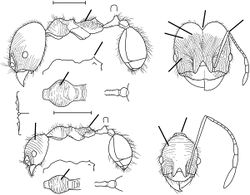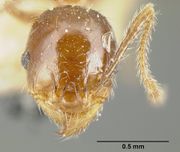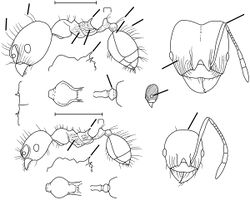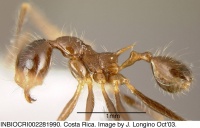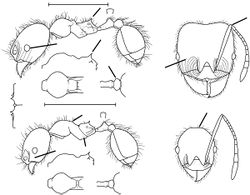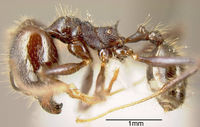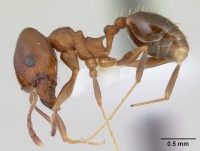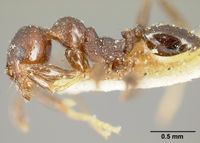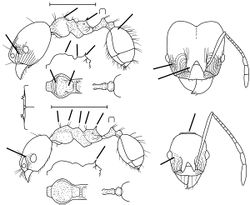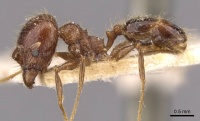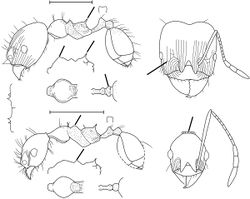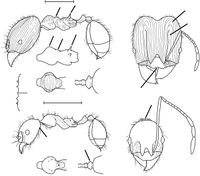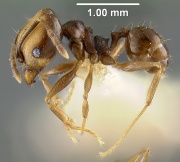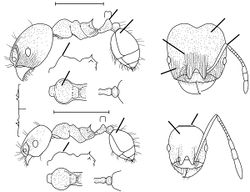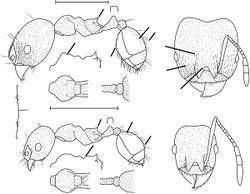Key to Pheidole diligens group
This worker key is based on: Wilson, E. O. 2003. Pheidole in the New World: A dominant, hyperdiverse ant genus. Harvard University Press, Cambridge, MA.
This large and diverse assemblage, almost exclusively Neotropical in distribution (I have recently seen one still undescribed species from the Patagonia Mountains of southern Arizona), comprises species of medium size, approximately heart-shaped heads, prominent mesonotal convexities, and restricted, mostly nonreticulate sculpturing. The diligens group is contiguous and even overlapping with the fallax group in the variation of these traits taken singly, but in the great majority of cases nest series can be placed in one or the other of the two groups by glancing at the full suite of characters. On the other hand, whether the group is monophyletic or a cluster of convergent subgroups remains to be determined. (One species, ''Pheidole riveti of Ecuador, cannot be keyed precisely here because the antennae of the lectotype are missing; check this species directly at decision points as noted in the key.)
You may also be interested in
1
- Propodeal spine greatly broadened and shortened or lacking altogether in the major and usually in the minor also; rather, the basal and descending faces of the propodeum viewed from the side come together to form a low, obtuse, or right angle . . . . . 2
- Propodeal spine present in major and minor, at least in the form of a denticle or small, raised acute angle . . . . . 10
2
return to couplet #1
- Major: antennal scape reaches or slightly exceeds the occipital corner . . . . . 3
- Major: antennal scape fails to reach the occipital corner by at least twice its own maximum width (also, check riveti) . . . . . 4
3
return to couplet #2
- Major: scape slightly exceeds occipital corner; occipital corner in full-face view subangular, not forming arc of circle (Amazonian Brazil, Paraguay) . . . . . Pheidole chrysops
 Pheidole chrysops, Major |
- Major: scape falls slightly short of occipital corner; occipital corner smoothly rounded to form the arc of a circle (Bolivia) . . . . . Pheidole vafella
 Pheidole vafella, Major |
4
return to couplet #2
- Major: most of dorsal surface of head capsule covered by longitudinal carinulae . . . . . 5
- Major: carinulae of head capsule almost entirely limited to small area near the eyes . . . . . 6
5
return to couplet #4
- Mesosoma of major and minor largely covered by transverse carinulae (Colombia) (also, check riveti) . . . . . Pheidole laelaps
- Mesosoma of major and minor lacking transverse carinulae (Amazonian Peru) . . . . . Pheidole demeter
6
return to couplet #4
- Pronotum and posterior dorsal half of head of minor partly covered by transverse carinulae (Costa Rica to Colombia) . . . . . 7
- Pronotum and posterior dorsal half of head of minor lacking carinulae, and instead is entirely smooth and shiny . . . . . 8
7
return to couplet #6
- Major: carinulae originating at inner side of eye travel transversely to the top of the antennal fossa. Minor: head possesses nuchal collar (Colombia) . . . . . Pheidole seligmanni
- Major: carinulae originating at inner side of eye travel anteriorly to the anterior margin of the head capsule. Minor: head lacks nuchal collar (Costa Rica to Colombia) . . . . . Pheidole alfaroi (in part - also #58)
 Pheidole alfaroi, Major |
8
return to couplet #6
- Major: head elongate (Head Length 1.2X Head Width). Minor: in side view, basal face of propodeum joins descending face in a smooth curve (Brazilian Amazon) . . . . . Pheidole strigosa
- Major: head not elongate (Head Length less than 1.1 X Head Width). Minor: juncture of basal and descending propodeal faces in side view bearing short spine or at least angulate (Costa Rica) . . . . . 9
9
return to couplet #8
- Major: scape broadened near the base, its width there equal to or greater than the maximum width of the transects along its distal half. Minor: dorsal surface of propodeurn lacks transverse carinulae . . . . . Pheidole vafra
 Pheidole vafra, Major |
- Major: scape much narrower near its base than in transects along its distal half. Minor: dorsal surface of propodeurn covered by transverse carinulae . . . . . Pheidole diana
 Pheidole diana, Major |
10
return to couplet #1
- Major: scape reaches within half of its own maximum width of the occipital corner, or exceeds it . . . . . 11
- Major: scape fails to reach occipital corner by at least half its own maximum width . . . . . 30
11
return to couplet #10
- Major: carinulae and other sculpturing immediately laterad to the frontal lobes (i .e., for a distance laterad equal to the Eye Length) either not extending beyond the level of posterior margin of the eye or, if they do, extending at most for a distance less than half the length of the eye; surface of head immediately laterad to the eye and posterior to it smooth and shiny . . . . . 12
- Major: carinulae and other sculpturing immediately laterad to the frontal lobes extending posteriorly past the posterior eye margin for a distance greater than the Eye Length; surface of head immediately laterad to the eye and posterior to it often sculptured . . . . . 26
12
return to couplet #11
- Major: profile of mesosoma completely bare of pilosity or at most with several standing hairs . . . . . 13
- Major: profile of mesosoma with abundant standing hairs . . . . . 15
13
return to couplet #12
- Major and minor: mesopleuron foveolate only, lacking carinulae and rugulae; scape exceeding margin of occipital corner by its length or slightly more; yellow (Brazilian Amazon) . . . . . Pheidole lemur
 Pheidole lemur, Major |
- Major and minor: mesopleuron with weak but distinct longitudinal carinulae or rugulae; scapes of major just reaching margin of occipital corner; dark brown (Central America) . . . . . 14
14
return to couplet #13
- Major: space between eye and antennal insertion partly rugoreticulate; propodeal spine straight and tapered to a point (Honduras) . . . . . Pheidole anima
 Pheidole anima, Major |
- Major: space between eye and antennal insertion entirely carinulate, with no rugoreticulurn; propodeal spine relatively thick and blunt-tipped (Guatemala) . . . . . Pheidole tschinkeli
15
return to couplet #12
- Major: scape exceeds the occipital corner by at least 2X its own maximum width . . . . . 16
- Major: scape just reaches the occipital corner, or extends beyond by no more than its own maximum width . . . . . 19
16
return to couplet #15
- Major and minor: in side view, propodeal spine at least half as long as the basal face anterior to it . . . . . 17
- Major and minor: in side view, propodeal spine less than one-fourth as long as the basal face anterior to it . . . . . 18
17
return to couplet #16
- Major: eye very large, its maximum length greater than the distance from its anterior border to the genal border; frontal lobes longitudinally carinulate (Amazonian Peru) . . . . . Pheidole scimitara
- Major: maximum eye length much less than the distance from the anterior border of the eye to the genal border; frontal lobes smooth and shiny (Costa Rica) . . . . . Pheidole tanyscapa
18
return to couplet #16
- Major: occiput bearing a tuft of standing hairs conspicuously denser than the hairs on the main dorsal surface of the head; within the occipital tuft on the surface is a “crown” of scattered but conspicuous foveae; major reddish brown, minor brownish yellow (widespread circum-Caribbean, possibly tramp species) . . . . . Pheidole longiscapa
 Pheidole cocciphaga, Major |
- Major: occiput lacking a special tuft of hairs or foveae on occiput; major reddish yellow, minor yellowish brown (Venezuela, Amazonian Brazil) . . . . . Pheidole longiscapa
 Pheidole longiscapa, Major |
19
return to couplet #15
- Major and minor: in side view, propodeal spine as long as the basal face of the propodeum anterior to it (Costa Rica) . . . . . Pheidole sicaria
 Pheidole sicaria, Major |
- Major and minor: in side view, propodeal spine less than one-fourth the length of the basal face anterior to it . . . . . 20
20
return to couplet #19
- Major: all of mesothorax and petiole smooth and shiny except for small patches of weak foveolae and rugulae on the lower part of episternum and center of side of propodeum (Colombia) . . . . . Pheidole tenuis
- Major: almost all of mesothorax and petiole foveolate and opaque . . . . . 21
21
return to couplet #20
- Major: several parallel carinulae run from each frontal lobe back over the head capsule to at least halfway between the level of the posterior border of the eye and the occipital border. . . . . . 22
- Major: carinulae from each frontal lobe reach at most a quarter of the distance from the level of the posterior border of the eye to the occipital border . . . . . 23
22
return to couplet #21
- Major and minor: parallel transverse carinulae prominent on anterior fourth of pronotum and also present on dorsal surface of propodeum of major; all of the side of major mesothorax (mesopleuron) foveolate and opaque (Panama to Bolivia) . . . . . Pheidole veletis
- Major and minor: several broken transverse carinulae present on extreme anterior strip of pronotum, and absent elsewhere on mesosomal dorsum of major and minor; lower half of major mesopleuron smooth and shiny (Sao Paulo, Brazil) . . . . . Pheidole perryorum
23
return to couplet #21
- Small (Head Width of major 0.8 mm) brown species. Minor: eye large and placed forward, its length as great as the distance from eye to anterior genal border (Amazonian Peru) . . . . . Pheidole machetula
- Larger (Head Width of major 0.9-1.0 mm), brown or yellow species. Minor: Eye Length much less than the distance of anterior border of eye to the anterior genal border . . . . . 24
24
return to couplet #23
- Major: in full-face view, no hairs project beyond the margin of head posterior to level of eyes; a small amount of rugoreticulum present, in addition to carinulae, between frontal lobe and eye (Santa Catarina, Brazil) . . . . . Pheidole laevifrons
- Major: in full-face view, dense hairs projecting beyond margin of head posterior to level of eyes; no rugoreticulum, only carinulae, present between frontal lobe and eye . . . . . 25
25
return to couplet #24
- Major: scape exceeds occipital corner by its own maximum width; eye small, its length only 0.14 mm; yellow (Ceara, Brazil) . . . . . Pheidole rochai
 Pheidole rochai, Major |
- Major: scape just reaches occipital corner; eye length 0020 mm; reddish brown (Santa Catarina, Brazil) (also, check chrysops) . . . . . Pheidole blumenauensis
 Pheidole blumenauensis, Major |
26
return to couplet #11
- Major and minor: dorsal surfaces of promesonotum and propodeum covered by parallel transverse carinulae (Venezuelan tepui) . . . . . Pheidole tepuicola
- Major and minor: dorsal surface of promesonotum and propodeum lack carinulae . . . . . 27
27
return to couplet #26
- Major: head sparsely pilose; when head is viewed full face, at most several hairs project beyond the occipital border . . . . . 28
- Major: head densely pilose; when head is viewed in full face, at least 10 and usually many more hairs project beyond the occipital border . . . . . 29
28
return to couplet #27
- Major: extensive area between eye and antennal insertion rugoreticulate; anterior fourth of first gastral tergite shagreened and opaque. Minor: propodeal spine well developed, in profile half as long as the propodeal basal face anterior to it (Costa Rica) . . . . . Pheidole pubiventris
 Pheidole pubiventris, Major |
- Major: area between eye and antennal insertion entirely cannulate, lacking rugoreticulum; all of first gastral tergite smooth and shiny. Minor: propodeal spine reduced to a tiny denticle (Coahuila, Mexico) . . . . . Pheidole ariel
29
return to couplet #27
- Major: in full-face view, parallel transverse and curving carinulae run from the posterior ends of frontal carinae to the eye; mesonotal convexity in side view evenly rounded. Minor: light brown with violaceous reflections (Costa Rica) . . . . . Pheidole violacea
 Pheidole violacea, Major |
- Major: in full-face view, carinulae originating from near posterior ends of frontal carinae run obliquely to a level well above the eye; mesonotal convexity in side view forming a blunt-tipped right angle. Minor: dark yellow, lacking violaceous reflections (Meta, Colombia) . . . . . Pheidole spilota
30
return to couplet #10
- Major: sculpturing between eye and antennal fossa at least in part rugoreticulate, i.e., consisting in part of at least several cross-carinulae that connect adjacent longitudinal carinulae . . . . . 31
- Major: no rugoreticulum between eye and antennal fossa, only concentric and longitudinal carinulae or unconnected rugulae . . . . . 56
31
return to couplet #30
- Major: a large part of the dorsal surface of the head posterior to the level of the eyes weakly rugoreticulate as well as foveolate, and opaque (Costa Rica) . . . . . Pheidole plebecula
 Pheidole plebecula, Minor |
- Major: no part of the dorsal surface of the head posterior to the level of the eyes bears a rugoreticulum . . . . . 32
32
return to couplet #31
- Major: pilosity very sparse; no hairs project anywhere beyond margin of head viewed in full face, except those projecting beyond anterior margin of clypeus . . . . . 33
- Major: pilosity moderately to very abundant; at least 5 or 6 hairs, usually many more, project beyond margin of head seen in full face, in addition to those at the anterior clypeal border . . . . . 47
33
return to couplet #32
- Major: entire rear half of dorsal surface of head foveolate and opaque . . . . . 34
- Major: rear half of dorsal surface of the head smooth and shiny, or at least the occiput and/or a broad central swath of the vertex smooth and shiny . . . . . 39
34
return to couplet #33
- Major: in side view, rear third of petiole bears a low node and is bent downward at a nearly right angle to the anterior peduncle (Mato Grosso, Brazil) . . . . . Pheidole cyrtostela
 Pheidole cyrtostela, Major |
- Major: in side view entire petiole straight and surmounted posteriorly by a high, well-developed node . . . . . 35
35
return to couplet #34
- Major: seen in side view, dorsal surface of first gastral tergite covered by dense felt of very short erect and suberect pubescence of even height, with a sparse scattering of much longer hairs; a pair of clavate hairs present on anterior dorsum of pronotum (Colombia) . . . . . Pheidole brandaoi
 Pheidole brandaoi, Major |
- Major: specialized pilosity described above not present . . . . . 36
39
return to couplet #33
- Major: pronotal dorsum smooth and shiny . . . . .40
- Major: pronotal dorsum foveolate and opaque . . . . . 44
40
return to couplet #39
- Major and minor: large (Head Width of major 1.6 mm) with long spines that equal in length the basal face of the propodeum anterior to it, viewed from the side; color very dark, from deep brown to black (Brazilian Amazon) . . . . . Pheidole lancifera
- Major and minor: smaller (Head Width of major 0.9-1.3 mm) with spines that are at most only slightly longer than half the length of the propodeal basal face anterior to it, in side view; color of species variously yellow to blackish brown . . . . . 41
41
return to couplet #40
- Major: a strip from eye to occiput foveolate and opaque; body dark brown, gaster black. Minor: occiput broad, lacking nuchal collar (Mexico, Costa Rica) . . . . . Pheidole piceonigra
 Pheidole piceonigra, Major |
- Major: region between eye and occiput smooth and shiny; according to species, most of body yellow to reddish brown. Minor: according to species, body with or without nuchal collar . . . . . 42
42
return to couplet #41
- Major: in full-face view, tip of scape reaches lateral margin of head much less than halfway from eye to occipital corner; humerus, in dorsal-oblique view (mesosoma rotated around long axis 45 degrees from top view), subangulate; head tricolored, with clypeus yellow, space between clypeus and level of eye light brown, and rest of head dark reddish brown (Amazonian Peru) . . . . . Pheidole davidsonae
- Major: in full-face view, tip of scape reaches lateral edge of head well above midpoint between eye and occipital corner; humerus, in dorsal-oblique view smoothly rounded; head concolorous yellow or brown . . . . . 43
43
return to couplet #42
- Major: scape approaches occipital corner to a distance of less than its own maximum width; in side view, propodeal spine longer than half the length of the basal face of the propodeum anterior to it; body yellowish to medium reddish brown. Minor: occiput broad, lacking nuchal collar (Costa Rica, Panama) . . . . . Pheidole perdiligens (=Pheidole plebecula)
 Pheidole plebecula, Minor |
- Major: scape approaches occipital corner to a distance about equal to twice its own maximum width; in side view, propodeal spine less than half as long as the basal face of the propodeum anterior to it; body dark brown. Minor: occiput narrow, with nuchal collar (Peruvian and Ecuadoran Amazon) . . . . . Pheidole gagates
44
return to couplet #39
- Major: all of dorsal surface of head capsule except occiput foveolate and opaque; all of frontal lobes and region between them posterior to the frontal triangle covered by parallel longitudinal carinulae (Argentina) . . . . . Pheidole nubila
 Pheidole nubila, Major |
- Major: at most only the anterior half of the dorsal head surface foveolate and opaque, the remainder smooth and shiny; a wide central space between frontal-lobe carinulae is smooth and shiny . . . . . 45
45
return to couplet #44
- Major: propodeal spine thin, needle-like, one-third as long as the dorsal face of the propodeum anterior to it. Minor: head narrowed posteriorly, with thin nuchal collar (Santa Cruz, Bolivia) . . . . . Pheidole zelata
- Major: propodeal spine thick, in side view, roughly equilateral-triangular in shape, only one-fourth as long as the dorsal face of the propodeum anterior to it. Minor: occiput broad, its border shallowly concave, lacking nuchal collar . . . . . 46
46
return to couplet #45
- Major: promesonotal profile, in dorsal-oblique view (mesosoma rotated around long axis 45 degrees from top view), contains 3 prominent convexities, 2 pronotal and one mesonotal. Minor: frontal lobes lack carinulae. Major and minor: yellow (Argentina, Bolivia, Brazil) . . . . . Pheidole triconstricta
Pheidole triconstricta, Major |
- Major: promesonotal profile, in dorsal-oblique view, contains only 2 prominent convexities, the pronotal and mesonotal respectively. Minor: frontal lobes possess longitudinal carinulae along outer edges. Major: light brown, anterior quarter of head capsule reddish yellow. Minor: medium brown (Minas Gerais, Brazil) . . . . . Pheidole geraesensis
 Pheidole geraesensis, Major |
47
return to couplet #32
- Major: pronotal dorsum foveolate and opaque . . . . . 48
- Major: pronotal dorsum smooth and shiny . . . . . 49
48
return to couplet #47
- Major: scape falls short of occipital corner by only 1 X its own maximum width; longest hairs on dorsa of pronotum and gaster 2X length of eye. Minor: occiput narrowed behind, with thin nuchal collar (Costa Rica) . . . . . Pheidole hoelldobleri
 Pheidole hoelldobleri, Major |
- Major: scape falls short of occipital corner by 2X its own maximum width; longest hairs on dorsa of pronotum and gaster only about as long as length of eye. Minor: occiput broad behind, and lacks nuchal collar (southern and central Brazil) . . . . . Pheidole rufipilis
 Pheidole rufipilis, Major |
49
return to couplet #47
- Major and minor: in side view, many hairs on the dorsa of head and gaster are 2X (and some 3X) length of eye (Brazilian and Amazonian Peru) . . . . . Pheidole longiseta
- Major and minor: in side view, at most only several hairs as long as 2X the length of the eye, the great majority much shorter . . . . . 50
50
return to couplet #49
- Major: longitudinal carinulae immediately mesad to eyes extending one-fourth or more the distance to the occipital border . . . . . 51
- Major: longitudinal carinulae immediately mesad to eyes not reaching beyond the posterior border of the eyes . . . . . 52
51
return to couplet #50
- Major: longitudinal carinulae immediately mesad to eyes reaching halfway to
occipital border; sides of mesonotal convexity and propodeum just above and in front of the spiracle carinulate (Argentina, southern Brazil) . . . . . Pheidole laevinota
 Pheidole laevinota, Major |
- Major: longitudinal carinulae immediately mesad to eyes reaching only one-fourth distance to occipital border; sides of mesonotal convexity and area above and front of propodeal spiracles lacking carinulae (Argentina) (placed in the fallax group; also keyed out here to ensure identification) . . . . . Pheidole pampana
 Pheidole pampana, Major |
52
return to couplet #50
- Major: in side view, dense layers of hairs project beyond both the dorsum and venter of the first gastral tergite, and in full-face view a similar dense fringe of hairs project from around the entire margin of the head (Argentina) (placed in the fallax group; also keyed out here to ensure identification) . . . . . Pheidole dione
 Pheidole dione, Major |
- Major: in side view, hairs are sparse along the profiles of the above segments, usually fewer than 10 on each tergite . . . . . 53
53
return to couplet #52
- Major: anterior fourth of first gastral tergite shagreened and opaque; in side view, propodeal spine more than half as long as the length of the basal face of the propodeum anterior to it. Minor: in full-face view, rear half of head strongly narrowed, with a conspicuous nuchal collar (Suriname, Amazonian Brazil) . . . . . Pheidole coffeicola
- Major: anterior fourth of first gastral tergite smooth and shiny; in side view, propodeal spine no more than one-third as long as the length of the basal face anterior to it. Minor: in full -face view, rear half of head only slightly or moderately narrowed, with at most a very thin, inconspicuous collar . . . . . 54
54
return to couplet #53
- Major: in side view, mesonotal convexity low, its length across the base 2X its height; propodeal spine short and blunt, approximately the shape of an equilateral triangle. Major and minor: clear dark yellow (southeastern Brazil) . . . . . Pheidole peregrina
 Pheidole peregrina, Major |
- Major: in side view, mesonotal convexity very prominent, approaching equilateral triangle in outline; propodeal spine longer and sharp, forming an acute triangle. Major and minor: yellowish brown to medium brown . . . . . 55
55
return to couplet #54
- Major: lower half of mesopleuron foveolate and opaque; anterior half of pronotal dorsum with several short transverse rugulae; yellowish brown, gaster a shade darker than rest of body. Minor: head narrowed somewhat posteriorly, with an inconspicuous nuchal collar (Colombia, Bolivia) . . . . . Pheidole seeldrayersi
 Pheidole seeldrayersi, Major |
- Major: lower half of mesopleuron smooth and shiny; pronotal dorsum lacking carinulae; reddish brown. Minor: head not tapered posteriorly and lacking a nuchal collar (Argentina and southern Brazil) (placed in the fallax group; also keyed out here to ensure identification; see also the closely similar eidmanni in the fallax group) . . . . . Pheidole nitidula
 Pheidole nitidula, Major |
56
return to couplet #30
- Major: in side view, rear third of petiole bearing a low node and bent downward at nearly a right angle to the anterior peduncle (Amazonian Brazil) . . . . . Pheidole camptostela
- Major: in side view entire petiole straight and surmounted by a high, well-developed node . . . . . 57
57
return to couplet #56
- Major: mesonotum and basal face of propodeum covered by parallel transverse carinulae . . . . . 58
- Major: mesonotum and usually also the basal face of propodeum lacking transverse carinulae . . . . . 59
58
return to couplet #57
- Major: entire dorsal surface of head posterior to eye level covered by parallel longitudinal carinulae. Minor: dorsal surface of head posterior to eye level lacking carinulae; occiput possesses a nuchal collar (Chile) . . . . . Pheidole chilensis
 Pheidole chilensis, Minor |
- Major: dorsal surface of head posterior to eye level lacking carinulae, instead smooth and shiny. Minor: dorsal surface of posterior half of head with transverse carinulae; occiput lacks a nuchal collar (Costa Rica to Colombia) . . . . . Pheidole alfaroi (in part - also #7)
 Pheidole alfaroi, Major |
59
return to couplet #57
- Major: viewed in full face, carinulae originating on the frontal lobes curve 45 degrees outward from the lobes just posterior to the eye level and continue on (like “eyebrows”) over the eyes to the edges of the head; posterior third of dorsum of head capsule covered with widely spaced but conspicuous foveae, its surface otherwise smooth and shiny; media caste (between major and minor) present (Costa Rica) . . . . . Pheidole boruca
 Pheidole boruca, Major |
- Major: carinulae originating on frontal lobes do not curve outward in “eyebrow” pattern; dorsal third of head lacks coarse foveae; media caste absent . . . . . 60
60
return to couplet #59
- Major: dorsal surface of head, including occiput, and all of the mesosoma foveolate, and opaque to subopaque; pilosity very sparse, with no hairs showing beyond margin of head, except for anterior margin of clypeus, when viewed in full face . . . . . 61
- Major: at least the occiput and usually large portions of the pronotum smooth and shiny; pilosity varies among species . . . . . 66
61
return to couplet #60
- Major: head bicolored, with occiput, sides of head, posterior strip of clypeus, and antennal fossae brown, and rest of surface yellow. Queen: head with similar color pattern, and abdomen phragmotic (Brazil, Ecuador, Peru) . . . . . Pheidole embolopyx
 Pheidole embolopyx, Major |
- Major: head more or less uniformly colored, lacking the unique pattern above. Queen: abdomen not phragmotic . . . . . 62
62
return to couplet #61
- Major: first gastral tergite entirely smooth and shiny . . . . . 63
- Major: at least the anteriormost strip of first gastral tergite shagreened and subopaque to opaque . . . . . 64
63
return to couplet #62
- Major: pronotal dorsum entirely covered with transverse carinulae. Minor: occiput in full-face view broad, lacking nuchal collar (Colombia, Venezuela) . . . . . Pheidole subnuda
- Major: pronotal dorsum with at most carinulae at anterior margin. Minor: occiput in full face narrowed, with nuchal collar (Colombia, Nicaragua) . . . . . Pheidole sagax
64
return to couplet #62
- Major: only the anterior fringe of the median strip of first gastral tergite shagreened and opaque; apex of petiolar node in side view tapering to a blunt point (Brazil, Peru) . . . . . Pheidole diligens
 Pheidole diligens, Major |
- Major: entire median strip of first gastral tergite shagreened and opaque; apex of petiolar node in side view rounded . . . . . 65
65
return to couplet #64
- Major: carinulae on frontal lobes limited to outer edges of the lobes, leaving a wide space between them covered only by foveolae. Major and minor: propodeal spine oriented strongly backward, forming in side view an angle of about 145 degrees with the propodeal basal face (central Brazil) . . . . . Pheidole fowleri
- Major: entire surface of the frontal lobes covered by parallel longitudinal carinulae. Major and minor: in side view, propodeal spine "stands up" from the basal propodeal face, forming an angle with it of about 135 degrees (Panama) . . . . . Pheidole hierax
66
return to couplet #60
- Major: at least the anteriormost strip of the first gastral tergite shagreened and opaque . . . . . 67
- Major: first gastral tergite entirely smooth and shiny . . . . . 68
67
return to couplet #66
- Major: in dorsal-oblique view (mesosoma rotated around long axis from top view), pronotum with angulate "sharkfin" protrusion; shagreening on first gastral tergite limited to anteriormost strip. Minor: occiput narrow, with nuchal collar (Colombia) . . . . . Pheidole venatrix
- Major: in dorsal-oblique view, pronotum smooth, rounded, lacking angulate protrusion; shagreening covers at least the anterior half of the first gastral tergite. Minor: occiput broad, lacking nuchal collar (Colombia, Curacao) . . . . . Pheidole inversa
 Pheidole inversa, Major |
68
return to couplet #66
- Major: the parallel longitudinal carinulae immediately mesad the eye extend posteriorly past the eye for a distance at least as long as the length of the eye itself . . . . . 69
- Major: parallel longitudinal carinulae immediately mesad to the eye, if present at all, do not extend posteriorly past the eye or, if they do, the extent is less than the length of the eye itself . . . . . 76
69
return to couplet #68
- Major: carinulae mesad to the eye extend posteriorly beyond the midpoint between level of posterior eye margin and occiput, where they break up into a patchwork of weak rugoreticulum; head bicolored, its anterior fifth brownish yellow and remainder light brown (Costa Rica) . . . . . Pheidole prostrata
 Pheidole prostrata, Major |
- Major: carinulae mesad to the eye extend posteriorly at most to the midpoint between posterior level of eye margin and occiput, and do not break up anywhere into a rugoreticulum; head a single color . . . . . 70
70
return to couplet #69
- Major and minor: extensive parallel transverse carinulae present on pronotum and mesopleuron. Major: viewed from the side, anterior third of lower surface of postpetiole bulges forward as a lobe (montane Colombia) (placed in the tristis group; also keyed out here to ensure identification) . . . . . Pheidole gaigei
 Pheidole gaigei, Major |
- Major and minor: at most, several transverse carinulae present on anterior half of major pronotum, and always absent in minor; anterior convexity weak or absent on postpetiolar ventral margin . . . . . 71
71
return to couplet #70
- Major: in profile, propodeal spine longer by at least half the length of the propodeal basal face anterior to it. Minor: pale yellow (desert, Dominican Republic) . . . . . Pheidole noar
- Major: in profile, propodeal spine only one-fourth as long as the basal propodeal face anterior to it . . . . . 72
72
return to couplet #71
- Large species (Head Width of major 1.9 mm). Major: frontal lobes covered by dense longitudinal carinae. Minor: conspicuous nuchal collar present (Brazil, Paraguay, Argentina) . . . . . Pheidole oxyops (in part - also #89)
 Pheidole oxyops, Major |
- Small to medium-sized species (Head Width of major at most 1.1 mm). Major and minor both lack transverse carinulae on pronotum. Major: only 10 or fewer widely spaced longitudinal carinae on frontal lobes. Minor: nuchal collar either present or absent . . . . . 73
73
return to couplet #72
- Small, slender species (Head Width of major less than 1.0 mm). Major: carinulae around midline of dorsal surface of head extend all the way to the occiput. Minor: nuchal collar present . . . . . 74
- Large, relatively stout species (Head Width of major 1.0 mm or more). Major: carinulae around midline of dorsal surface of head extend less than halfway from level of eye to occiput. Minor: nuchal collar absent. . . . . . 75
74
return to couplet #73
- Major: propodeal spine well developed; carinulae immediately mesad to the frontal carinae reach only halfway from the level of the eye to the occiput (widespread, tropical South America) . . . . . Pheidole cataractae
 Pheidole cataractae, Major |
- Major: propodeal spine reduced to a denticle; carinulae immediately mesad to the frontal carinae reach three-fourths the way from the level of the eye to the occiput (Colombia) . . . . . Pheidole calimana
 Pheidole calimana, Major |
75
return to couplet #73
- Major: parallel transverse carinulae present on anterior fifth of pronotum; in side view, profile of the posterior third of the pronotum is elevated slightly but distinctly above the anterior two-thirds by a short face (Galapagos) . . . . . Pheidole williamsi
 Pheidole williamsi, Major |
- Major: carinulae absent from pronotum; in side view, dorsal profile of pronotum forms a smooth convex curve (Lima, Peru) . . . . . Pheidole crozieri
76
return to couplet #68
- Major: profile of dorsa of mesosoma, petiole, and postpetiole, as well as of the circumference of sides of head and occiput, completely devoid of pilosity . . . . . 77
- Major: profile of above body parts with numerous hairs projecting beyond their margins . . . . . 79
77
return to couplet #76
- Major and minor: in dorsal-oblique view (mesosoma rotated around long axis 45 degrees from top view), outline of pronotum constitute a double convexity (Grenada, West Indies, and Brazil) . . . . . Pheidole bruesi
- Major and minor: in dorsal-oblique view, outline of pronotum consists of a single, subangular convexity . . . . . 78
78
return to couplet #77
- Major: scape approaches occipital corner to within a distance 1 X its own maximum width; light reddish brown, with a medium brown spot on the vertex (Ecuador) . . . . . Pheidole stigma
- Major: scape fails to reach the occipital corner by 3X its own maximum width; concolorous pale yellow (Brazilian and Peruvian Amazon) . . . . . Pheidole laidlowi
 Pheidole laidlowi, Major |
79
return to couplet #76
- Major: pilosity over dorsal surface of body very long, some of the hairs exceeding 2X the length of the eye . . . . . 80
- Major: pilosity over dorsal surface only moderately long, with few if any of the hairs reaching 1.5X the length of the eye, and most or all not as long as the eye . . . . . 82
80
return to couplet #79
- Major: pronotal dorsum covered by parallel transverse carinulae, the interstices foveolate and opaque (Rio de Janeiro, Brazil) . . . . . Pheidole reichenspergeri
 Pheidole reichenspergeri, Major |
- Major: pronotal dorsum at most with several transverse carinulae on its anterior third, and all the remaining surface smooth and shiny . . . . . 81
81
return to couplet #80
- Major: dorsum of first gastral tergite seen in side view bearing a small number of very long hairs along its margin, many over 2X Eye Length. Minor: occiput narrow, bearing a posterior nuchal collar (Brazil, Colombia) . . . . . Pheidole pubiventris
 Pheidole pubiventris, Major |
- Major: dorsum of first gastral tergite in side view covered by a dense layer of hairs of highly variable length, none over 1.5X Eye Length. Minor: occiput broad and lacks a posterior nuchal collar (Costa Rica to southern Brazil) . . . . . Pheidole sensitiva
 Pheidole sensitiva, Major |
82
return to couplet #79
- Major and minor: propodeal spine very thin, sharp, and needle-like; head long and narrow (Head Length 1.16X greater than Head Width in major and 1.33X greater in minor) (Amazonian Peru) . . . . . Pheidole aciculata
- Major and minor: propodeal spine not needle-like; head shorter in proportion (Head Length 1.00- 1.1 OX greater than Head Width in major and l.07-1.23X in minor) . . . . . 83
83
return to couplet #82
- Major: in side view, dorsa of head and first gastral tergite covered by dense, appressed hairs, many of which are aligned almost parallel to the surface of the segments . . . . . 84
- Major: in side view, dorsa of head and first gastral tergite bearing mostly suberect to erect hairs . . . . . 85
84
return to couplet #83
- Major: in side view, hairs of first gastral tergite shorter than half the length of the eye; hypostomum bearing 4 teeth. Minor: occiput broad, lacking nuchal collar (Ecuador) . . . . . Pheidole cameroni
 Pheidole cameroni, Major |
- Major: in side view, most hairs of first gastral tergite as long as the eye; hypostomum bearing 2 teeth. Minor: occiput narrow, with nuchal collar (upland Costa Rica) . . . . . Pheidole biolleyi
 Pheidole biolleyi, Major |
85
return to couplet #83
- Major and minor: when the propodeal dorsum is seen in dorsal-oblique view (mesosoma rotated around long axis 45 degrees from top view), a convexity appears at the center of the edge of its basal face that is nearly as high as the propodeal spine; propodeal spine small, only a tenth as long as the propodeal basal face anterior to it. Major: viewed from above, the outer edges of the postpetiole are subangular. A larger species (Head Width of major 1.4 mm) (Bolivia) . . . . . Pheidole quiaccana
- Minor and major: lacking convexity on oblique outer edge of propodeal basal face; spine length variable. Major: seen from above, outer edges of postpetiole evenly rounded. Smaller species (Head Width of major 1.0-1.3 mm) . . . . . 86
86
return to couplet #85
- Major and minor: mesonotal convexity very low, nearly absent in minor, and in both castes its length is 8X or more its height . . . . . 87
- Major and minor: mesonotal convexity prominent, its length 5X or less its height . . . . . 88
87
return to couplet #86
- Major: erect hairs forming a dense fringe around the head viewed in full face; propodeal spine half as long as the basal propodeal face anterior to it (montane Ecuador) . . . . . Pheidole alpestris
- Major: exclusive of clypeus, pilosity around edge of head viewed in full face sparse, consisting of only 10 or so erect and suberect hairs; propodeal spine less than half as long as the basal propodeal face (montane Peru) . . . . . Pheidole accinota
88
return to couplet #86
- Major: tip of scape touches the border of the head midway between level of the posterior margin of the eye and level of the occiput . . . . . 89
- Major: tip of scape touches the border of the head two-thirds or more from level of the posterior margin of the eye to the level of the occiput . . . . . 90
89
return to couplet #88
- Large species (Head Width of major about 1.9 mm); head capsule concolorous light reddish brown. Minor: occiput narrow, with a nuchal collar (Brazil, Paraguay, Argentina) . . . . . Pheidole oxyops (in part - also #72)
 Pheidole oxyops, Major |
- Smaller species (Head Width of major about 1.3 mm); head capsule bicolored, its anterior one-third yellowish brown and its posterior two-thirds medium brown. Minor: occiput broad, lacking nuchal collar (Costa Rica) . . . . . Pheidole indistincta (=Pheidole pubiventris)
 Pheidole pubiventris, Major |
90
return to couplet #88
- Major: scape approaches occipital corner within IX of its own maximum width; Head Length only 1.02X greater than Head Width. Major and minor: clear yellow (southeastern Brazil) . . . . . Pheidole angusta
 Pheidole angusta, Major |
- Major: scape falls short of occipital corner by at least 2X its own maximum width; Head Length 1.08-1.1 OX Head Width. Major and minor: light to medium brown . . . . . 91
91
return to couplet #90
- Major: dorsal surfaces of head and pronotum in side view covered by dense mat of erect hairs; in dorsal-oblique view (mesosoma rotated around long axis 45 degrees from top view), profile of pronotum is a smooth convexity; head capsule faintly bicolored, with anterior third yellowish brown and posterior two-thirds a slightly contrasting light brown (widespread in disturbed habitats from Santa Catarina in Brazil to Trinidad and Costa Rica) . . . . . Pheidole vafra
 Pheidole vafra, Major |
- Major: dorsal surfaces of head and pronotum in side view with sparse pilosity, constituting no more than 20 hairs on each of these two surfaces; in dorsal-oblique view, profile of pronotum is shallowly bilobed; head capsule concolorous medium reddish brown (Veracruz, Mexico) . . . . . Pheidole insipida
 Pheidole insipida, Major |





